Excerpts from Jim Conrad's
Naturalist Newsletter
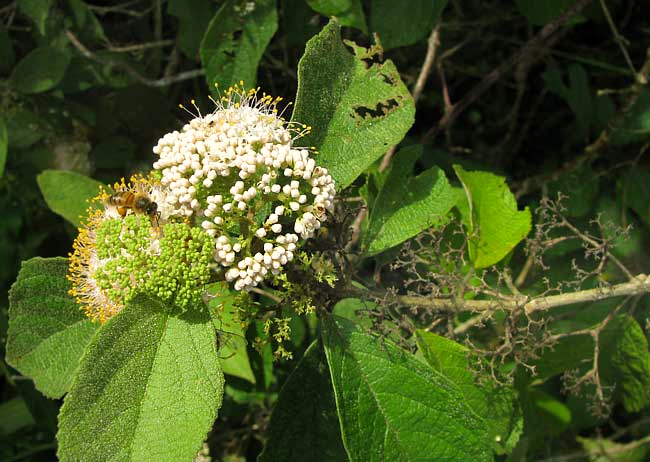
from the October 31, 2010 Newsletter issued from Hacienda Chichen Resort beside Chichén Itzá Ruins, central Yucatán, MÉXICO; limestone bedrock, elevation ~39m (~128ft), ~N20.676°, ~W88.569°
BEAUTYBERRIES
You can see a roadside bush fairly common around here above. Actually, that picture of flowers was taken in early September. Now the bushes are fruiting, as shown below:
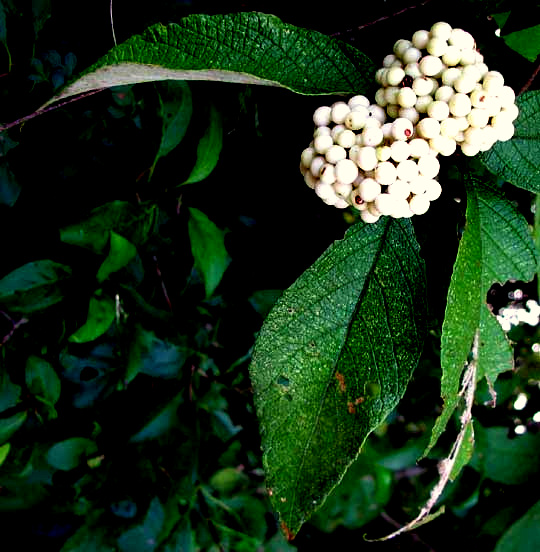
I've put off introducing this pretty, frequently seen bush until now because I was uncertain about its ID.
From the first I recognized the bush's similarity to Beautyberry, Callicarpa americana, which is so conspicuous nowadays in the US Deep South, with its gaudily pink-violet clusters of pithy fruits, shown at www.backyardnature.net/n/w/beauty-b.htm.
So, is there a Beautyberry -- a member of the genus Callicarpa -- listed for the Yucatan? Yes, CALLICARPA ACUMINATA. Moreover, the description of Callicarpa acuminata fits our bushes in every respect... except this: Callicarpa acuminata nearly always is described as producing very dark purple or black fruits, while our bushes' fruits have been white for two months and show no sign of darkening.
However, the US's Beautyberry has produced a white-fruited cultivar, and I find at least one mention on the Internet of our shrub sometimes producing white fruits, so I'm going ahead and calling it a Callicarpa acuminata. If you need an English name for it, "White-fruited Mexican Beautyberry" would be good as any.
I read that the Maya take a cold-water infusion of the crushed leaves to halt diarrhea and dysentery.
By the way, our beautyberry's leaves are interestingly rough (scabrous), wrinkled (rugose), and bear tiny, star-shaped (stellate) hairs. A close-up showing a little morning dew gathered among the hairs is shown below:
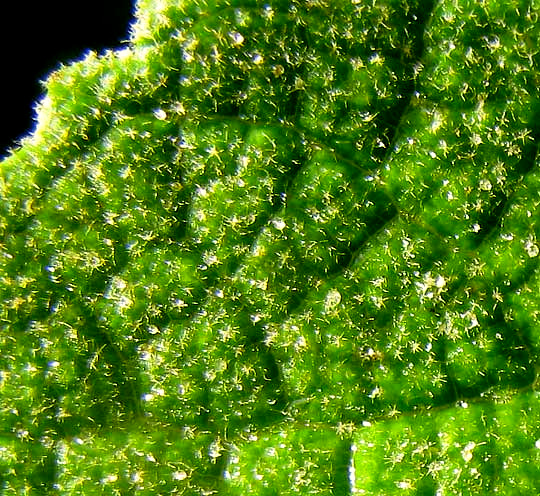
from the November 8, 2015 Newsletter issued from Hacienda Chichen Resort beside Chichén Itzá Ruins, central Yucatán, MÉXICO
MEXICAN BEAUTYBERRY WITH BLACK FRUITS
As is the case now, in October of 2010 at woods edges along roadsides in the Pisté area there were numerous shrubs with dense, attractive clusters of white fruits, shown in the above entry. Something noted there is that "Callicarpa acuminata nearly always is described as producing very dark purple or black fruits, while our bushes' fruits have been white for two months and show no sign of darkening." For the last five years I've wondered about that.
Nowadays more information about Mexican Beautyberry is available. The species' fruit picture posted by CICY, the Yucatan's Center for Scientific Investigation, shows white fruit, and the Wikipedia author for the species admits that sometimes white fruits are produced. And this week I found Mexican Beautyberries bearing black fruits mingling with those producing white fruits, which is a situation I've not seen mentioned in the literature.
Below, you can see a nice cluster of elderberry-black fruits of the type apparently most common over the rest of the species' distribution:
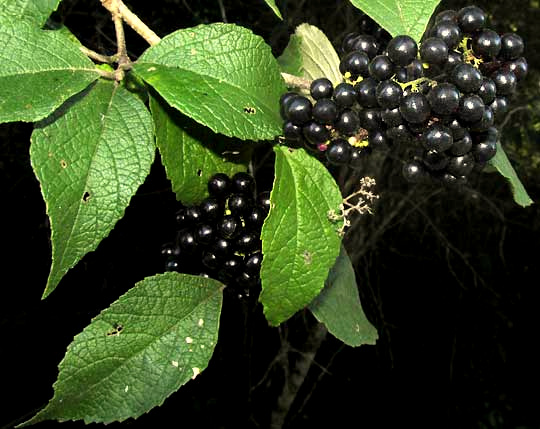
Green fruits maturing directly to dark purple or black with no white intermediate stage apparent are seen below:
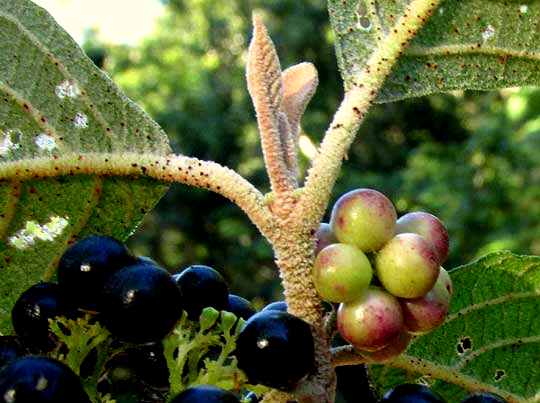
Most authors simply ignore our white-fruited plants, often calling Callicarpa acuminata Black Beautyberry. An online database for taxonomy, Tropicos, lists four varieties of the species, without describing them, so maybe we have mingling varieties here. That would be unusual, though, since usually mingling varieties interbreed with one another, and tend to form intermediate organisms, not intermingling ones.
In the old days the Beautyberry genus Callicarpa was placed in the Verbena Family but nowadays usually it's assigned to the Mint Family, though its herbage doesn't smell minty and the fruit isn't deeply four-lobed.
While looking for medicinal uses of Callicarpa acuminata, in Google Books I stumbled upon a 2003 publication by Marianna Kunow, published by UNM Press (University of New Mexico), entitled Medicine: Traditional Healing in Yucatan. It describes the practices of curanderos, or traditional herb doctors, right here in Pisté. Kunow writes of Callicarpa, "to cure diarrhea and vomiting. Soak a bunch of leaves in cold water with a little sugar. Drink daily until cured." The local Maya call the bush X Pukim